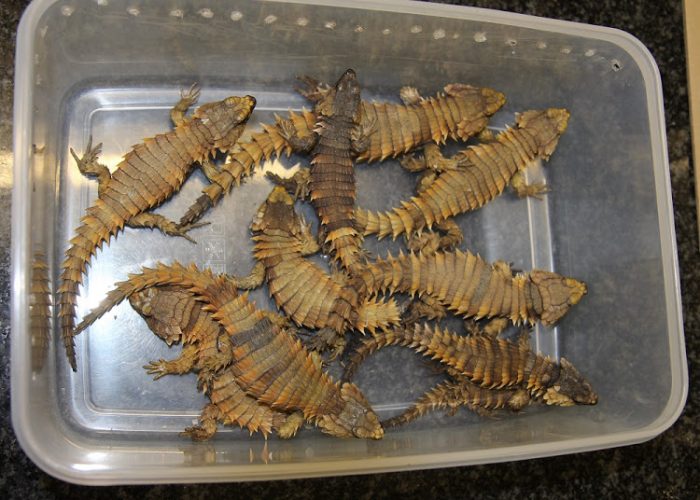

They are born with a thin membranous body cover, which they break open after birth. During birth, the newborn has an average body length of seven inches. After a gestation period of around six to eight months, females give birth to a single (rarely two) offspring. Usually, breeding takes place during spring. Reproduction: While most of the lizard species are egg-laying in nature, armadillo lizards are among those who give birth to young ones. Communication is mainly through movements of tail, head and tongue. These lizards are active during daytime and are slow-moving. However, females may move out of the group and mate with other males. Males are highly territorial and are found to mate with females in their territory only. They change groups frequently, especially during mating. Sometimes, all the members of a group share a single crevice. Usually, a group comprises an adult pair with juveniles and sub-adults. Though the defensive mechanism of armadillo lizards is an effective deterrent for most of the potential predators, birds of prey feed on them.īehavior: Armadillo lizards are mostly found in groups of around 2 to 60 members. Primarily, they are carnivores, but these lizards may also eat plant material (leaves and fruits). Their diet includes spiders, scorpions, millipedes and beetles. Prey and Predators: They usually feed on insects, especially termites. These lizards are well adapted to desert life. Their habitat includes dense vegetation (comprising shrubs and small trees) and rocky areas, as they require hiding spaces to escape from predators and to hibernate. Range and Habitat: Armadillo lizards live in the deserts along the west coast of southern Africa. Habitat, Food Habits, Behavior, and Reproduction However, if there is no other way, they are found to drop the tail as the last resort. This is because of their unique defensive posture, which requires the tail to be held tightly in the mouth.


Though tail autotomy is one of the strategies that lizards use to escape from their predators, this practice is not so common in armadillo lizards. They can stay in that posture for almost an hour. It is due to this defensive posture that these lizards are called armadillo lizards. This defensive mechanism is one of the armadillo lizard adaptations, because the posture protects their soft belly, as only the scaly back is exposed. However, birds of prey still feed on these lizards. When they are in their defensive posture, the spines become prominent and that thorny look is not at all appealing for most of the predators. These lizards too roll up to form a ‘spiny ring’, by grabbing the tail in the mouth, whenever they face danger. It is a common fact that an armadillo can (mammals) roll into a ball, when it is threatened. The unique feature of an armadillo lizard is its defensive posture. The flat body structure helps them to squeeze in and crawl out of cracks and crevices easily, so as to escape from predators. Structure: Armadillo lizards have a slightly flattened head and a stocky body. Their tail length could be equal to or slightly lesser than the body length. The snout-to-vent (measurement from the nose tip to the anus) length could be up to five inches. Size: These lizards grow to a maximum length of seven to nine inches. Their body color may slightly vary with different species. The ventral part sports a comparatively lighter shade of yellow. The color may range from grayish brown to dirty yellow with brownish blotches. So they are also known as girdled lizards.Ĭolor: Armadillo lizards are usually brownish yellow in color. The scales on the body are usually found to be arranged in girdles. They have spiny scales covering almost the entire body, including the tail, limbs, neck, and head. Spines: The defensive posture of armadillo lizards involves the display of spines to scare away predators and enemies. They are now listed ‘VULNERABLE’, by the International Union for Conservation of Nature (IUCN). With the ever-increasing fascination for exotic pets, these lizards too are hunted for pet trade, which is one of the main reasons for their dwindling population. Armadillo lizards ( Cordylus cataphractus) are found in the African deserts. However, they possess an inbuilt armor in the form of a hard, scaly and spiny skin. Though they are not related to each other, armadillos and armadillo lizards share a common trait – an armored body, which they use for defending themselves from predators.Ĭan you visualize a lizard with an armored body? No, the reptile does not have a helmet or a bulletproof vest, like the mighty humans.


 0 kommentar(er)
0 kommentar(er)
